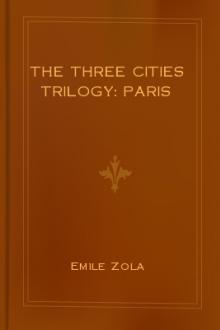The Three Cities Trilogy: Paris by Émile Zola (speld decodable readers txt) 📕

- Author: Émile Zola
- Performer: -
Book online «The Three Cities Trilogy: Paris by Émile Zola (speld decodable readers txt) 📕». Author Émile Zola
And you can see what he has become with it all: a humbug with a diseased mind!”
“It’s a terrible symptom,” muttered Pierre, “when through ennui or lassitude, or the contagion of destructive fury, the sons of the happy and privileged ones start doing the work of the demolishers.”
Francois had resumed his walk, going down towards the ornamental water, where some children were sailing their boats. “That fellow is simply grotesque,” he replied; “but how would you have sane people give any heed to that mysticism, that awakening of spirituality which is alleged by the same doctrinaires who started the bankruptcy of science cry, when after so brief an evolution it produces such insanity, both in art and literature? A few years of influence have sufficed; and now Satanism, Occultism and other absurdities are flourishing; not to mention that, according to some accounts, the Cities of the Plains are reconciled with new Rome. Isn’t the tree judged by its fruits? And isn’t it evident that, instead of a renascence, a far-spreading social movement bringing back the past, we are simply witnessing a transitory reaction, which many things explain? The old world would rather not die, and is struggling in a final convulsion, reviving for a last hour before it is swept away by the overflowing river of human knowledge, whose waters ever increase. And yonder, in the future, is the new world, which the real young ones will bring into existence, those who work, those who are not known, who are not heard. And yet, just listen! Perhaps you will hear them, for we are among them, in their ‘quarter.’ This deep silence is that of the labour of all the young fellows who are leaning over their work-tables, and day by day carrying forward the conquest of truth.”
So saying Francois waved his hand towards all the day-schools and colleges and high schools beyond the Luxembourg garden, towards the Faculties of Law and Medicine, the Institute and its five Academies, the innumerable libraries and museums which made up the broad domain of intellectual labour. And Pierre, moved by it all, shaken in his theories of negation, thought that he could indeed hear a low but far-spreading murmur of the work of thousands of active minds, rising from laboratories, studies and class, reading and lecture rooms. It was not like the jerky, breathless trepidation, the loud clamour of factories where manual labour toils and chafes. But here, too, there were sighs of weariness, efforts as killing, exertion as fruitful in its results. Was it indeed true that the cultured young were still and ever in their silent forge, renouncing no hope, relinquishing no conquest, but in full freedom of mind forging the truth and justice of to-morrow with the invincible hammers of observation and experiment?
Francois, however, had raised his eyes to the palace clock to ascertain the time. “I’m going to Montmartre,” he said; “will you come part of the way with me?”
Pierre assented, particularly as the young man added that on his way he meant to call for his brother Antoine at the Museum of the Louvre. That bright afternoon the Louvre picture galleries were steeped in warm and dignified quietude, which one particularly noticed on coming from the tumult and scramble of the streets. The majority of the few people one found there were copyists working in deep silence, which only the wandering footsteps of an occasional tourist disturbed. Pierre and Francois found Antoine at the end of the gallery assigned to the Primitive masters. With scrupulous, almost devout care he was making a drawing of a figure by Mantegna. The Primitives did not impassion him by reason of any particular mysticism and ideality, such as fashion pretends to find in them, but on the contrary, and justifiably enough, by reason of the sincerity of their ingenuous realism, their respect and modesty in presence of nature, and the minute fidelity with which they sought to transcribe it. He spent days of hard work in copying and studying them, in order to learn strictness and probity of drawing from them—all that lofty distinction of style which they owe to their candour as honest artists.
Pierre was struck by the pure glow which a sitting of good hard work had set in Antoine’s light blue eyes. It imparted warmth and even feverishness to his fair face, which was usually all dreaminess and gentleness. His lofty forehead now truly looked like a citadel armed for the conquest of truth and beauty. He was only eighteen, and his story was simply this: as he had grown disgusted with classical studies and been mastered by a passion for drawing, his father had let him leave the Lycee Condorcet when he was in the third class there. Some little time had then elapsed while he felt his way and the deep originality within him was being evolved. He had tried etching on copper, but had soon come to wood engraving, and had attached himself to it in spite of the discredit into which it had fallen, lowered as it had been to the level of a mere trade.
Was there not here an entire art to restore and enlarge? For his own part he dreamt of engraving his own drawings, of being at once the brain which conceives and the hand which executes, in such wise as to obtain new effects of great intensity both as regards perception and touch. To comply with the wishes of his father, who desired each of his sons to have a trade, he earned his bread like other engravers by working for the illustrated newspapers. But, in addition to this current work, he had already engraved several blocks instinct with wonderful power and life.
They were simply copies of real things, scenes of everyday existence, but they were accentuated, elevated so to say, by the essential line, with a maestria which on the part of so young a lad fairly astonished one.
“Do you want to engrave that?” Francois asked him, as he placed his copy of Mantegna’s figure in his portfolio.
“Oh! no, that’s merely a dip into innocence, a good lesson to teach one to be modest and sincere. Life is very different nowadays.”
Then, while walking along the streets—for Pierre, who felt growing sympathy for the two young fellows, went with them in the direction of Montmartre, forgetful of all else,—Antoine, who was beside him, spoke expansively of his artistic dreams.
“Colour is certainly a power, a sovereign source of charm, and one may, indeed, say that without colour nothing can be completely represented.
Yet, singularly enough, it isn’t indispensable to me. It seems to me that I can picture life as intensely and definitely with mere black and white, and I even fancy that I shall be able to do so in a more essential manner, without any of the dupery which lies in colour. But what a task it is! I should like to depict the Paris of to-day in a few scenes, a few typical figures, which would serve as testimony for all time. And I should like to do it with great fidelity and candour, for an artist only lives by reason of his candour, his humility and steadfast belief in Nature, which is ever beautiful. I’ve already done a few figures, I will show them to you. But ah! if I only dared to tackle my blocks with the graver, at the outset, without drawing my subject beforehand. For that generally takes away one’s fire. However, what I do with the pencil is a mere sketch; for with the graver I may come upon a find, some unexpected strength or delicacy of effect. And so I’m draughtsman and engraver all in one, in such a way that my blocks can only be turned out by myself. If the drawings on them were engraved by another, they would be quite lifeless… . Yes, life can spring from the fingers just as well as from the brain, when one really possesses creative power.”
They walked on, and when they found themselves just below Montmartre, and Pierre spoke of taking a tramcar to return to Neuilly, Antoine, quite feverish with artistic passion, asked him if he knew Jahan, the sculptor, who was working for the Sacred Heart. And on receiving a negative reply, he added: “Well, come and see him for a moment. He has a great future before him. You’ll see an angel of his which has been declined.”
Then, as Francois began to praise the angel in question, Pierre agreed to accompany them. On the summit of the height, among all the sheds which the building of the basilica necessitated, Jahan had been able to set up a glazed workshop large enough for the huge angel ordered of him. His three visitors found him there in a blouse, watching a couple of assistants, who were rough-hewing the block of stone whence the angel was to emerge. Jahan was a sturdy man of thirty-six, with dark hair and beard, a large, ruddy mouth and fine bright eyes. Born in Paris, he had studied at the Fine Art School, but his impetuous temperament had constantly landed him in trouble there.
“Ah! yes,” said he, “you’ve come to see my angel, the one which the Archbishop wouldn’t take. Well, there it is.”
The clay model of the figure, some three feet high, and already drying, looked superb in its soaring posture, with its large, outspread wings expanding as if with passionate desire for the infinite. The body, barely draped, was that of a slim yet robust youth, whose face beamed with the rapture of his heavenly flight.
“They found him too human,” said Jahan. “And after all they were right.
There’s nothing so difficult to conceive as an angel. One even hesitates as to the sex; and when faith is lacking one has to take the first model one finds and copy it and spoil it. For my part, while I was modelling that one, I tried to imagine a beautiful youth suddenly endowed with wings, and carried by the intoxication of his flight into all the joy of the sunshine. But it upset them, they wanted something more religious, they said; and so then I concocted that wretched thing over there. After all, one has to earn one’s living, you know.”
So saying, he waved his hand towards another model, the one for which his assistants were preparing the stone. And this model represented an angel of the correct type, with symmetrical wings like those of a goose, a figure of neither sex, and commonplace features, expressing the silly ecstasy that tradition requires.
“What would you have?” continued Jahan. “Religious art has sunk to the most disgusting triteness. People no longer believe; churches are built like barracks, and decorated with saints and virgins fit to make one weep. The fact is that genius is only the fruit of the social soil; and a great artist can only send up a blaze of the faith of the time he lives in. For my part, I’m the grandson of a Beauceron peasant. My father came to Paris to set himself up in business as a marble worker for tombstones and so forth, just at the top of the Rue de la Roquette. It was there I grew up. I began as a workman, and all my childhood was spent among the masses, in the streets, without ever a thought coming to me of setting foot in a church. So few Parisians think of doing so nowadays. And so what’s to become of art since there’s no belief in the Divinity or even in beauty? We’re forced to go forward to





Comments (0)